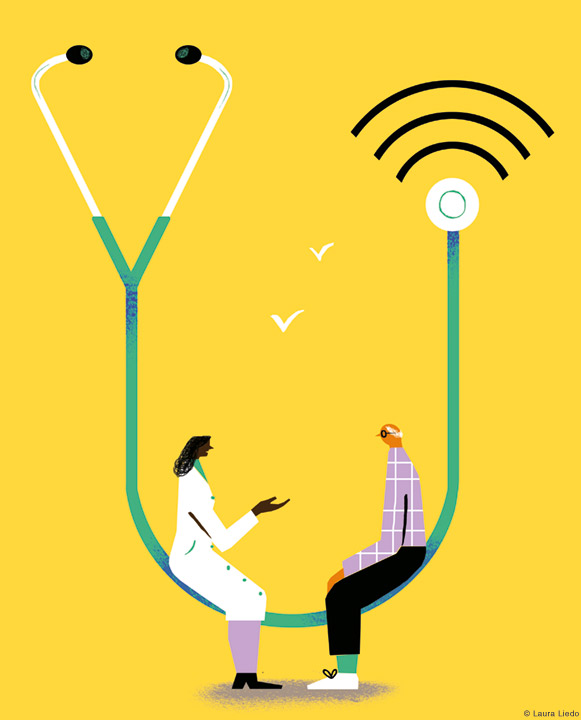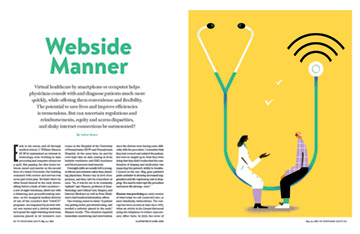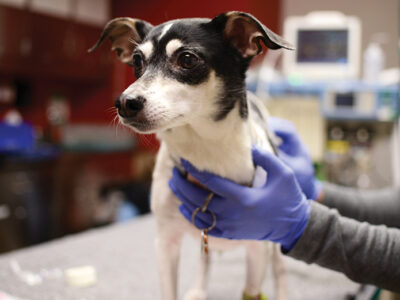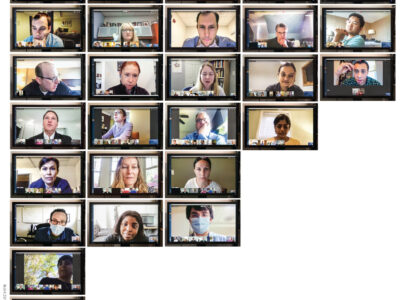
Virtual healthcare by smartphone or computer helps physicians consult with and diagnose patients much more quickly, while offering them convenience and flexibility. The potential to save lives and improve efficiencies is tremendous. But can uncertain regulations and reimbursements, equity and access disparities, and shaky internet connections be surmounted?
By JoAnn Greco | Illustration by Laura Liedo

Early in his career, and all through medical school, C. William Hanson III M’83 maintained an interest in technology, even working in data processing and computer science for a spell. But passing the dim hours between sunset and sunrise on the second floor of a bland University City building crammed with routers and servers was never part of his plan. Yet that’s where he often found himself in the early 2000s: sitting before a bank of video monitors—a sort of night watchman, albeit one with a lifesaving and groundbreaking mission—as the inaugural medical director of one of the country’s first “teleICU” programs. Accompanied by several critical care nurses and a clerical assistant, he’d spend the night watching feeds from cameras placed in 30 intensive care rooms at the Hospital of the University of Pennsylvania (HUP) and Pennsylvania Hospital. At the same time, he and his crew kept tabs on data coming in from bedside ventilators and EKG machines and blood pressure instruments.
Overnight shifts are usually left to younger fellows and residents rather than attending physicians. Nurses vary in level of experience, and they can’t be everywhere at once. “So, it was for me to be constantly vigilant,” says Hanson, professor of Anesthesiology and Critical Care, Surgery, and Internal Medicine as well as Penn Medicine’s chief medical information officer.
One evening comes to mind. “A patient was getting sicker, just deteriorating, and needed a catheter placed in the neck,” Hanson recalls. “The situation required immediate monitoring and intervention since the doctors were having some difficulty with the procedure. I remember that they had covered and sedated the patient, but were so caught up in what they were doing that they didn’t realize that the combination of draping and medication was impacting the patient’s ability to breathe. I turned on the mic. Hey, your patient’s pulse oximeter is showing decreased oxygenation and the respiratory rate is dropping. You need to interrupt the procedure and access the airway—now.”
Hanson was practicing an early version of what today we call connected care, or more familiarly, telemedicine. The concept has been around at least since 1879, when an article in the Lancet discussed using the telephone to reduce unnecessary office visits. In 1925, the cover of Science and Invention magazine showed a doctor diagnosing a patient over radio.
Distance monitoring developed more fully during the Mercury space program when NASA’s ground control captured medical information from orbiting space capsules. In recent years, telemedicine has been used mainly for doctor-to-doctor communications, and it’s proven tremendously effective. New research from the Perelman School of Medicine and Independence Blue Cross, for example, examines data from a period in 2016–17 when primary care physicians transmitted photos over a secure application to a dermatologist instead of referring patients to make an in-person appointment with the specialist. The response time dropped from 84 days—the time frame between referrals, next available office appointment, and diagnosis—to under five hours, with no significant increase in medical costs.
Lauren Eberly is one clinician who’s been engaging with local providers in places like Rwanda and Liberia to review patient data and telementor to help support patient care remotely across the world for years. “I’ve always thought that we should utilize this technology more to interact directly with patients and reach patients with barriers to accessing care,” says Eberly, a fellow in cardiovascular medicine and an associate fellow at Penn’s Leonard Davis Institute of Health Economics with an interest in healthcare disparities and inequity.
“A lot of us have been wanting and waiting to move telehealth to the patient end for a long time. It can be such an asset for patients who find it really hard to get to a clinic and who can feel so much more comfortable in their own homes,” she adds. “And for physicians, it offers the chance to see into their environments, to peek in their medicine cabinets or to invite family into the picture for insights on how everyone is doing.
“But there was no impetus until the coronavirus forced everyone to look more closely at how we could make it happen.”
The New House Call
By the end of March 2020, telehealth visits had increased by 154 percent compared to the same week the prior year, according to the Centers for Disease Control and Prevention—which prompted an outpouring of the future has arrived studies and articles. One report last summer from McKinsey & Company predicted that “with the acceleration of consumer and provider adoption of telehealth and extension of telehealth beyond virtual urgent care, up to $250 billion of current US healthcare spend [compared to $3 billion pre-COVID] could potentially be virtualized.”
Suddenly, a new term entered our lexicon, one which, broadly speaking, encompasses both synchronous care—like that first video call you took from your doctor during the pandemic—and asynchronous, which might involve, say, collection of your blood pressure or glucose levels from that smartwatch you’re constantly checking. The common take: think of telemedicine as the new house call.
Hanson remembers his dad, an old-fashioned general practitioner, making old-fashioned visits to patients’ homes. “That was the paradigm then—the doctor came to you,” he says. “Then we got into a prolonged period where the patient came to the doctor, the service, the test. It didn’t matter how far away or close it was. A lot of inconvenience and inefficiency entered the system.” Just ask anyone who’s taken hours off from work, driven in circles searching for a parking spot, and sat in a waiting room for 45 minutes—after scheduling an appointment weeks in advance.
While the benefits are clear, so are the questions. Among them: access, equity, inclusivity, patient and doctor comfort levels, insurer and regulator resistance, privacy and security concerns, and—more than a year into the pandemic—Zoom fatigue. “The shift isn’t going to be easy,” says George Demiris, a professor of informatics at the Perelman School of Medicine.
Hanson knows that. Since assuming the role of chief medical information officer when it was created 11 years ago, he’s been steadfastly pulling together the system’s disparate telehealth threads, trying to get a handle on the limiting factors while attempting to expand Penn Medicine’s efforts beyond doctor-to-doctor interactions and into patients’ living rooms. When the pandemic struck, “we had pretty good foundations in place,” he says. “Our experience with what we now call the Penn E-lert eICU was extremely helpful during that initial COVID-19 storm when the ICUs were overwhelmed. We were so impressed by the benefits that we now are covering upwards of 350 ICUs using the technology.”
But supporting ICUs as they adjusted to an onslaught of patients deathly ill from a little-understood malady was just a part of the work. No matter how much experience they had under their belts, Penn and other healthcare providers had to ramp up hard—and fast. When cities went into lockdown, medical offices shuttered right along with restaurants, gyms, and hair salons. Not only would telehealth reduce patient demand on overwhelmed healthcare facilities, suggested the CDC, it could also expand access to care, reduce disease exposure for staff and patients, and preserve scarce supplies of personal protective equipment. As it adhered to those recommendations, Penn jumped from fewer than 1,000 telemed visits a month to 7,500 a day. “We went from a period of ‘it’s nice to have,’ to ‘it’s absolutely essential,’” Hanson says.
The McKinsey report observed that American consumers’ adoption of telehealth skyrocketed—from 11 percent in 2019 to 46 percent—in light of cancelled in-person visits. That growth was seen across all kinds of systems, with managed care consortium Kaiser Permanente reporting that more than 80 percent of its appointments were conducted by phone or video during April 2020 compared to 15 percent prior to the pandemic, and an ever-expanding breed of telehealth-only platforms with internet-ready names like iCliniq, Amwell, and MeMD experiencing similar leaps.
The largest, oldest, and first publicly traded one in the bunch, Teladoc Health, for example, clocked a 100 percent increase in virtual visits from the first week of March to the first week of April last year. All told, in 2020 the company directly delivered 10.6 million virtual visits, and enabled another 3.9 million visits for the 600 hospitals and health systems that use its proprietary platforms. “If you think about consumer life cycles, it’s like we raced through the awareness phase, almost skipped the adaptation part, and got to the point where this is the expected norm all at once,” says Teladoc CEO Jason Gorevic C’93.
A Long Time Coming
Teladoc was on an upward trajectory even before the pandemic. Founded as a service offering remote phone consultations in 2002, around the time when Penn was debuting its teleICU, the company grew slowly. “I actually thought it would move a lot faster,” recalls Gorevic, who became its CEO in 2009.
Gorevic was a senior at Penn when the Clinton administration’s ultimately unsuccessful push for healthcare reform inspired him. He didn’t want to be a doctor but wondered if there was another way he could help fix the system. After graduating, he landed at Oxford Health, where he was involved in the design, development, and management of a telephone medical advice service staffed by registered nurses. He then spent five years outside of the healthcare arena, working at early-stage tech companies like mail.com, which he helped take public in 1999.
He’d do the same for Teladoc in 2015, a pivotal year in which the company also embarked on a series of acquisitions that continues to this day and sued the Texas Medical Board for ruling that physicians had to personally meet patients before remotely treating them. (A 2017 bill allowed virtual care without prior in-person contact.) By the end of 2015, Teladoc notched its one millionth virtual visit ever; two years later it was hosting that many visits annually, and in 2019 it reached that number in its first quarter. More than 70 million Americans now have access—primarily via their employers and insurers—to the 7,000 clinicians in the Teladoc Health Medical Group. “We’re not in the business of disrupting healthcare,” Gorevic says. “We’re in the business of transforming it.”
Hanson agrees. “I believe the model that Teladoc offers as a vendor—to help someone with a sore throat, a cough, a headache, reach a doctor quickly—is a modern paradigm that works,” he says. “We’ve spoken with them, but we’ve chosen to stay in-house.” That was achievable because the system already had a clinical informatics team established, as well as the tech chops in place. “But we had to develop things like virtual private rooms, messaging capabilities, and workflow systems on the fly,” he adds.
People like Srinath Adusumalli GM’18 Gr’18 Gr’21, who serves as assistant chief medical information officer in addition to teaching at Penn Medicine in his cardiovascular specialty, were ready to help. “Even two years ago, the tech wasn’t really there,” he says. “Plus there were barriers to an increased uptake when it came to reimbursement and regulation, plus the workflow was not to scale. So we started by figuring out who the patients are, who we should use this with; then, what about the patient preference; then on to making sure that patients and providers get into the room at the same time; then after the visit, making sure they get all of the required follow-ups and testing” and more. Everything from booking appointments to staying in touch with patients in between visits (mostly by text), to sending and fitting patients with remote monitoring devices where appropriate, had to be worked out.
Adusumalli and the telemed team were also charged with delivering a training program for systemwide clinicians on how to use the video vendor platform BlueJeans and developing an overlay application, Switchboard, that connects the system’s electronic health record (EHR), sends text messages, and handles all of the other logistics. Security concerns governed the preference for proprietary software, adds Mary Elisabeth (Liz) Deleener, director of network telemedicine. “We hold privacy to the highest standard,” she says, “which is why we don’t allow any of the thousands of providers who use the system to go with any tech platform they want. Multiple platforms mean multiple risks.”
Overcoming Obstacles
There were certainly bumps in the early days of the pandemic—Teladoc, for instance, scrambled to add new doctors to its networks, and some patients struggled with uncharacteristically long wait times for appointments. But for the industry in general, the “incremental improvements over time, not only from the tech standpoint but regarding regulations about state boundaries and insurance reimbursements, definitely helped,” observes Deleener. “The barriers were starting to come down, but COVID opened the floodgates.” The Trump administration quickly expanded access to and coverage of telemedicine—previously limited to virtual check-ins, on-site clinics (such as at a workplace), and rural populations—for Medicare members. Almost as immediately, many state licensing boards began issuing waivers to the restriction that doctors and nurses attend to patients based only in the states in which they practice. The Telehealth Modernization Act of 2020, a bill now in the Senate, aims to permanently remove many of the regulatory restrictions on telehealth that were temporarily lifted.
Another obstacle that’s been chipped away: the reluctance of both doctors and patients to try new things. Hanson remembers that hesitancy surrounding the teleICU. “There was some pushback, along the lines of Big Brother is watching me,” he says. “But we were able to show that having this extra layer of oversight, or support, depending on how you looked at it, was associated with decreased mortality, fewer complications, lower costs, and shorter ICU stays.”
Deleener, a clinical nurse by practice, says “it was brand new when I started, and I remember standing in front of a video monitor and thinking, How am I going to use this thing to treat my patient? It’s no different than any other kind of change in methods clinicians have gone through—like moving from paper to the EHR and being intimidated. But now I think clinicians understand that virtual visits are meant to supplement treatment where appropriate and best for the patient. If you use it in the right circumstances, and the patients have access, and the technology is high quality, most clinicians find that they are able to do their work much more efficiently.”
With familiarity has come comfort. “When it became basically mandatory and the only way to continue seeing patients, clinicians quickly adapted,” says Demiris. “It was interesting to hear them say, Why weren’t we using this before? It was forced compliance, which I think is sometimes the only way to go with these kinds of changes.”Now, some Penn providers are even reserving their evenings and weekends to hold telemed clinics in order to free up their weekdays for patients requiring in-person visits.
Penn clinicians aren’t alone in their embrace of this new world. More than 75 percent of clinician respondents to a recent survey by the American Medical Association and several other organizations “said telehealth had enabled them to provide quality COVID-19-related care, acute care, chronic disease management, hospital or emergency department follow-up, care coordination, preventative care, and mental or behavioral health. … Sixty percent reported that telehealth has improved the health of their patients, while more than 80 percent indicated that telehealth improved the timeliness of care for their patients. A similar percentage said that their patients have reacted favorably to using telehealth for care.” In the McKinsey report cited earlier, 57 percent of providers said they viewed telehealth more favorably than they did pre-COVID and 64 percent were more comfortable using it; patient approval was even greater, with 76 percent indicating they were highly or moderately likely to use virtual healthcare going forward and 74 percent of telehealth users describing themselves as highly satisfied. And, says Gorevic, “we even have physicians who come to us because they want to dedicate the entirety of their care to the virtual market.”
The scope of what can be done virtually has widened considerably beyond the call-a-pediatrician-at-two-in-the-morning “urgent care” that was the original modus operandi for enterprises like Teladoc. Offering access to practitioners in some 450 subspecialties, from dermatologists to dietitians, Teladoc says that despite the initial pandemic surge, less than 10 percent of its 2020 visits wound up being COVID-related. In some areas such as mental and behavioral health, adds Gorevic, “we’ve moved more and more towards creating longitudinal relationships rather than episodic ones.” A relatively new Teladoc initiative, Primary 360, is another example, as it attempts to fill the void for the roughly 25 percent of Americans (and the 45 percent of 18- to 29-year-olds, according to Kaiser Permanente) who have no primary care physician.
Another demographic that can benefit greatly from virtual healthcare is older adults and their caretakers, points out Demiris, whose research focuses mainly on designing and evaluating how technology can be used in geriatrics. “When you think about COVID, it was the elders who were told they should stay where they were,” he says. “Telemedicine was of great help in bridging the distance and delivering care to people.”
Demiris is interested in seeing the technology go much further, though. In partnership with the School of Nursing (where he also teaches) and with funding from the National Institute on Aging and the CDC, he’s studying the efficacy of sensors that calculate escalating fall risk by assessing a wearer’s gait and balance. Since those living in low-resource neighborhoods with poor housing conditions have twice the risk of falling, the study will consider refinements to the product based on feedback from low-income older adults, their caretakers, and clinicians.
Easing Access
There’s no overlooking that telemedicine’s promise is tempered by a persistent digital divide. “There are plenty of older adults who don’t own a computer or a smartphone or have internet access or experience with technology,” Demiris says. “What happens to them—or people who are hard of hearing, or visually impaired, or who don’t speak English? More needs to be done on designing systems that are flexible, intuitive, easily adaptable, and inclusive.”
Eberly recently served as lead author of a detailed study looking at the experiences of nearly 150,000 patients who were scheduled for an in-person visit at Penn Medicine during the first two months of the pandemic. Just over half completed a telehealth visit instead (the rest were cancellations or no-shows), split fairly evenly between video and telephone.
The study noted various inequities: older, Asian, and non–English-speaking patients had lower rates of telemedicine use, and older, female, Black, Latinx, and poorer patients in particular were associated with less video (as opposed to telephone) use. As far as language goes, Eberly says “since we were able to notice very early on that non-English speakers were opting not to participate in remote visits, we started integrating a new program that reaches out right away in most major languages, as well as American sign language. With just one click, the user can choose simultaneous translation.”
To counteract some of the other barriers, Eberly and Adusumalli (who served as senior writer for the study) are part of a team trying to secure funding for a pilot program to develop, distribute, and provide training for Connected Care kits that would include patient-appropriate diagnostic tools or apps (such as a blood pressure cuff, EKG monitor, or glucometer) and an internet- and video-enabled tablet preloaded with access to the myPennMedicine portal.
Into the Future
As hospital systems and commercial virtual health providers tackle these issues, they are also keeping an eye on the future to learn how they can expand their care options. “We are researching and piloting various virtual peripheral tools,” says Deleener. “But we’re proceeding relatively slowly.”
Gorevic seems antsier, his foot resting lightly on the brake while he waits at the yellow light. “There’s a boom in connected devices and self-diagnostic testing that’s going to expand the scope of what we can do without the consumer having to go to a medical facility,” he says. “We want to be prepared to take advantage of them when they receive approval and come to market.”
It’s tempting to think that devices such as these—which meld artificial intelligence, augmented reality, and algorithm technologies with traditional medical instruments like stethoscopes—“are all wonderful, with no downsides and nothing to complain about,” says Hanson. “That’s not appropriate—but neither is the Luddite philosophy that says this is a poor substitute for an in-person encounter. These are improvements that can significantly affect the overall medical experience for the better. If someone can be seen sooner and diagnosed faster, if we can catch something earlier, if someone doesn’t have to move on to an ER or wait for a specialist, we’re saving lives and saving money.”
In one pre-COVID survey conducted at Penn, researchers found that even low-tech remote interventions can help. They saw a fourfold reduction in rehospitalizations of hip- or knee-replacement patients who enrolled in a program that collected data from wearable step counters and used conversational text messaging to “hover” over them and encourage them to meet milestones for recovery.
There’s a still softer, more holistic side to this, too, one that allows clinicians to gain a richer perspective about their patients’ lives. “Our providers are always telling me, You know, I got really interesting insights from seeing Mrs. Smith in her kitchen or her bedroom. It was surprisingly organized, or I didn’t realize she had so many steps to climb,” says Hanson.“We see our patients for such a limited time in our office and we miss what happens where they’re out in their own world. It’s a huge opportunity.”
But clinicians, just like the rest of us, will have to learn to improve their webside manner. “Healthcare providers have to be trained how to deliver empathy over a video call,” observes Demiris. “We did a course at Penn Nursing on that, remembering to look straight into the camera, expressing agreement by nodding more than you might normally. The in-person element can never be fully conveyed online, but on the other hand there is some literature that says that some distancing can help with patients who feel embarrassed or reluctant to discuss private matters.” The AMA has produced several tutorials on the subject, advising clinicians to, among other things, dress professionally, make sure patients are set up technically, have a backup plan, and create in-depth conversation.
Today’s medical students are, almost by definition, a lot more comfortable with FaceTiming and texting and downloading apps, points out Allison Hare, who is taking a year out of her medical training at Penn to complete a clinical informatics fellowship with Hanson. She’s created a course, offered this spring, that examines the potential of clinical informatics. “The overall goal is to generate interest from the students in the tech-med space,” she says. “Among my peers, there’s a lot of excitement about creating smart health systems. The interpersonal dynamic is a huge component of what so many of us love about practicing medicine. Making technology another way to connect with a patient, to help them create a care plan that they’re comfortable with, is something that I and other medical students feel will be really big going forward.”
For Hanson, who’s had a year now to digest the transformation of an initiative that was “more or less a backwater into something that suddenly became front and center in the delivery of our mission,” the traffic light is already green to drive forward. “I spent at least 10 years trying to build up this capacity in our organization, so I’m not being Pollyannaish when I say that I’m confident that telemedicine has a significant role to play in traditional medical care—and it would have taken a lot longer to get where we’ve gotten without the pandemic forcing our hand. So that’s been a kind of ray of optimism and hope in the midst of what’s been a very challenging time for our providers and our patients.“
JoAnn Greco is a frequent contributor to the Gazette.




